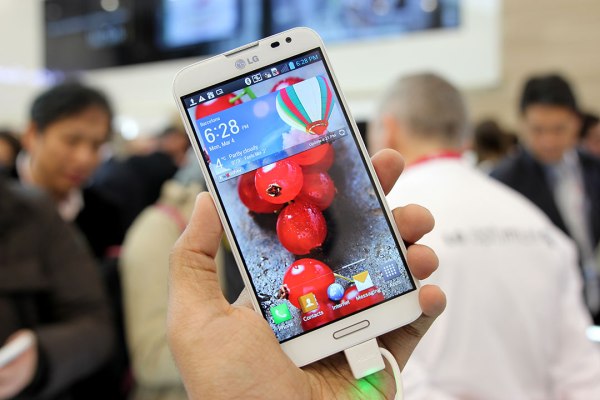The last time I bought an LG smartphone — the unabashedly brown G2x — I had to return it after a few weeks because it would randomly reboot if I so much as looked at it funny. From then on, I convinced myself that I just couldn’t buy another LG phone. They just weren’t worth the headache.
After playing with LG’s Optimus G Pro here at MWC, I’m starting to rethink that decision.
Fine, it may not be as new as the L II series, but I still think it’s a far more compelling device to spend time with. But first, a quick note. As confusing as it is, there are technically two versions of the Optimus G Pro — a variant meant for Japan with a 5-inch display, and a Korean-spec G Pro with a larger 5.5 panel that will hit the United States some time this spring. That latter version is the one on display here, and despite some minor shortcomings, it easily seems like one of the best smartphones LG has ever made.
As usual, LG has crafted a very light, very slim plastic chassis for the G Pro. It’s more than a little reminiscent of Samsung’s Galaxy design language, though LG does what it can to set the G Pro apart from its big rival with little flourishes — think the “pixelated” back and the IR blaster located along the device’s top edge. Under that back plate lives a removable 3,140 mAh battery — not bad at all, though it’s right in line with the battery seen in the Galaxy Note 2.
A 13-megapixel camera features prominently on the G Pro’s rear end, and while I really doubt that you’d be able to tell from some the photos I snapped, image quality seemed impressive. Slightly less impressive was the G Pro’s Panorama feature — in theory it’s similar to the Photo Sphere feature baked into Android 4.2, but the implementation here is more confusing and the results not as polished. Some other camera tweaks (like the ability to record video from both the front and rear cameras at the same time) are just as neat, and actually work great.
Tucked inside that body is a Snapdragon 600 processor (like the one seen in HTC’s fancy new One flagship) clocked at 1.7GHz along with 2GB of RAM, so the whole affair is very snappy — there’s zero lag to be seen while swiping around and poking in and out of apps, even with LG’s busy custom UI in place. Visual clutter aside, that UI seems to be a fairly flimsy veneer over stock Android 4.1.2, so purists may not bristle quite as much as usual if they took a chance and bought one of these things.
While I’m pontificating about visuals, I should mention that the G Pro’s 5-inch, 1080p IPS display is plenty bright and sharp (think 400 PPI) to boot. Color reproduction still isn’t quite as vivid as its competitors (a side effect of the screen technology at play here), but as I’ve noted before, my eyes may have just grown accustomed to the often lurid colors seen on AMOLED panels like those featured in Samsung’s high-end smartphones.
On a related note, I’m surprised at how quickly I’ve grown accustomed to these sorts of hefty handsets. It used to be that anything with a screen larger than four inches felt awfully unwieldy, but the Optimus G Pro and big ol’ screen just felt natural in my hand. Your mileage will almost certainly vary on that front, but overall the G Pro is a much more comfortable device than its screen size lets on.
Naturally, I’m waiting until I get my hands on a final review unit before passing judgment, but the G Pro shows plenty of promise. Whether or not LG will actually be able to convince jaded consumers to buy it is another story entirely. I will say this, though — if the rumors are true and Google really is working on a new Nexus phone based on the Optimus G Pro, it’ll be one of those devices that you just can’t buy fast enough.

